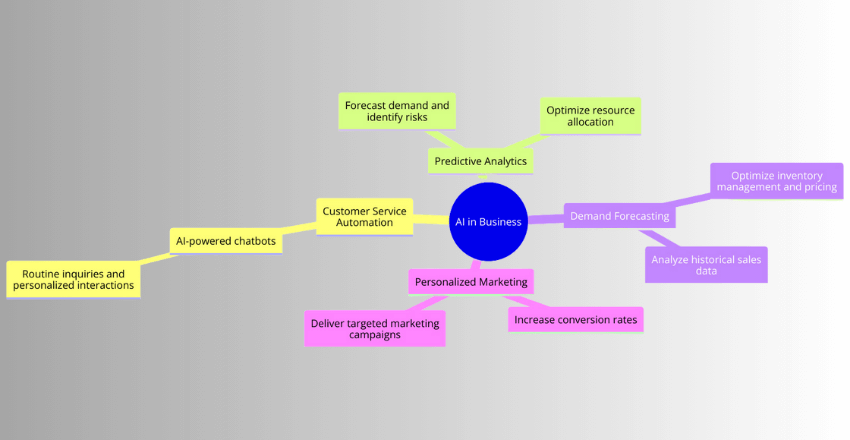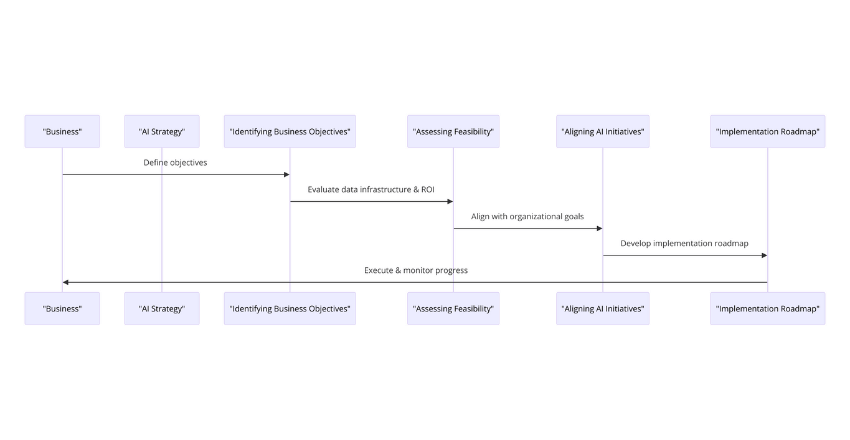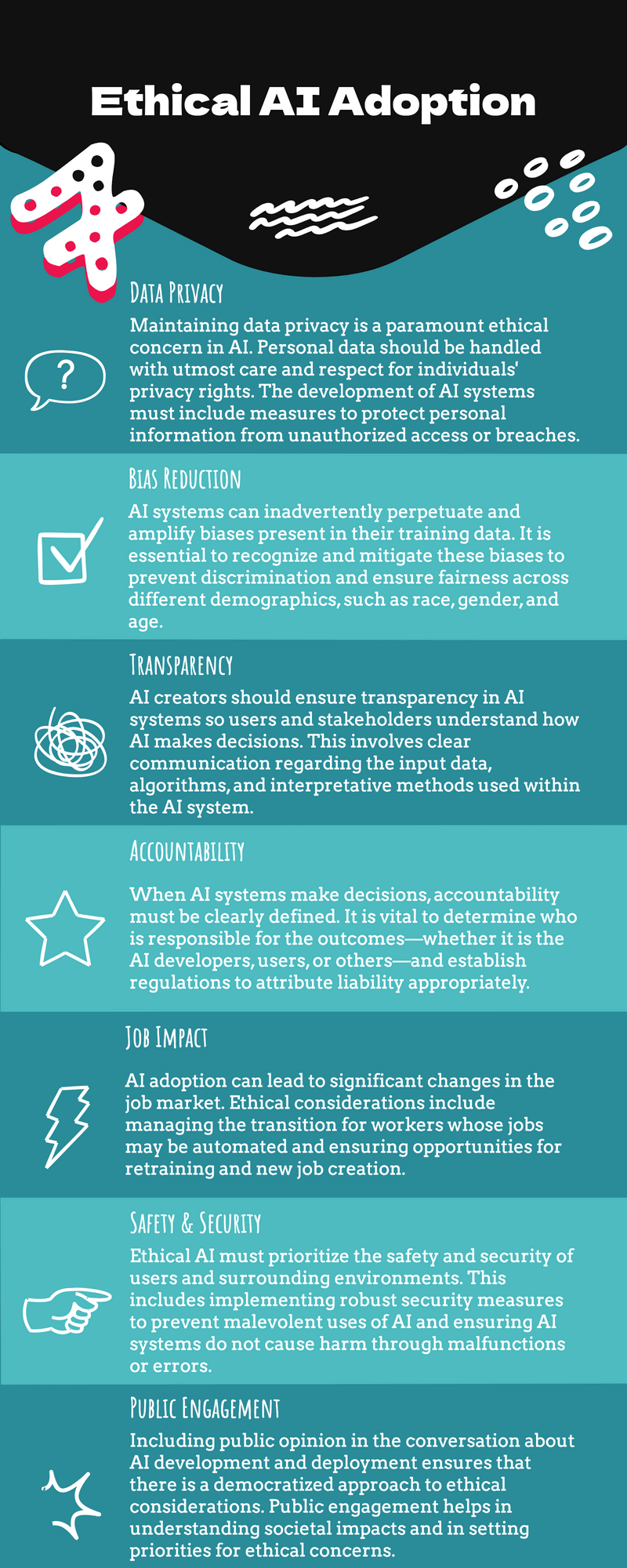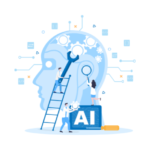
AI for Business: Revolutionize your operations with smart automation, data-driven decisions, and personalized customer experiences to outpace the competition.
As AI continues to shift from a buzzword to a mainstream business tool, it’s crucial for organizations to understand its potential impact on business growth and transformation.
The Role of AI in Business
Artificial Intelligence (AI) has emerged as a game-changer for enterprises, driving business transformation on a scale never seen before. From automating mundane tasks to unlocking critical insights from large datasets, AI is proving to be a disruptive force in the business world.
Implementing AI in business requires a strategic approach and a clear understanding of the potential benefits it can provide. AI-driven business transformation can improve efficiency, reduce costs, and create new revenue streams. However, it is essential to have a comprehensive understanding of the role of AI in business to maximize its potential.
AI for Enterprises
Enterprises across industries are leveraging AI to gain a competitive advantage. The potential applications of AI in business are many and varied. AI-powered chatbots and virtual assistants are being used to enhance customer service and provide personalized experiences.
Predictive analytics is being used to forecast demand and optimize supply chain operations. AI is also being used to develop more accurate risk models and improve fraud detection in financial services.
The implementation of AI in business can drive transformative changes in corporate strategy and operations. By automating routine tasks, employees can focus on higher-value activities such as innovation and creativity.
AI can also provide business leaders with real-time insights, helping them make informed decisions that can drive growth and profitability.

Implementing AI in Business
Implementing AI in business requires a significant investment of time and resources. It is essential to have a clear understanding of the business problem that needs to be solved and the potential benefits of AI in addressing that problem.
Organizations must also consider the data infrastructure needed to support AI applications. Data quality, security, and accessibility are critical factors to consider when implementing AI in business. Investing in the right talent and skills is also essential to ensure successful AI adoption in business.
By understanding the role of AI in business, enterprises can leverage its potential to drive business growth and transformation.
Practical Applications of AI in Business

Artificial Intelligence (AI) has been widely adopted in the business world to drive performance, productivity, and growth. Across various industries, businesses are exploring AI-driven solutions to improve customer service, optimize operations, and enhance decision-making processes.
Below are some practical applications of AI in business:
- Customer Service Automation: Many businesses are implementing AI-powered chatbots to automate customer service. Chatbots can handle routine inquiries, freeing up human agents to focus on more complex tasks. Chatbots can also personalize customer interactions and improve response time.
- Predictive Analytics: AI-driven predictive analytics can help businesses forecast demand, identify potential risks, and optimize resource allocation. By leveraging machine learning algorithms, businesses can gain insights into customer behavior, market trends, and risks.
- Demand Forecasting: Similar to predictive analytics, demand forecasting can help businesses optimize inventory management and pricing. By analyzing historical sales data and market trends, businesses can make informed decisions about production, distribution, and pricing.
- Personalized Marketing: AI-powered marketing solutions can personalize the customer journey and increase conversion rates. By analyzing customer data and behavior, businesses can deliver targeted marketing campaigns and recommendations.
These AI-driven solutions are just a few of the practical applications of AI in business. More and more, businesses are exploring the potential of AI to drive performance, productivity, and growth. Business AI strategies are evolving, and AI is becoming an essential component of the corporate landscape.
Overcoming Challenges in AI Adoption
The adoption of AI can bring transformative changes to businesses. However, it also comes with challenges that must be addressed. In this section, we will discuss the common obstacles that businesses encounter when implementing AI and provide practical insights and strategies to overcome them.
Data Privacy
One of the biggest concerns surrounding AI adoption in business is data privacy. As businesses collect and store vast amounts of data, it is essential to ensure that it is kept safe and secure. AI algorithms require access to large amounts of data to function, and this can put business and customer data at risk.
To overcome this challenge, businesses must implement strong data protection policies and protocols to mitigate the risks of data breaches and cyber-attacks. This includes conducting regular security audits, providing data encryption and access controls, and implementing user authentication measures.
Ethical Considerations
The use of AI in business operations raises ethical considerations that must be addressed. Bias and fairness in AI algorithms, privacy concerns, and the responsible use of AI technology are some of the areas of focus. To overcome this challenge, businesses must develop ethical guidelines and strategies for implementing AI solutions.
This includes conducting thorough ethical reviews of AI algorithms and considering the potential impact on society, such as job displacement and social inequalities.
Skill Gaps
The successful adoption of AI in business requires a skilled workforce that can develop, implement, and maintain AI solutions. It is essential to bridge the skill gap in AI development and deployment to ensure that businesses can leverage AI-driven solutions.
To overcome this challenge, businesses can invest in AI training programs and partnerships with leading educational institutions and AI development teams from South America, which have a strong track record of producing highly skilled AI talent.
Integration Complexities
A common challenge in AI adoption is integrating AI solutions with existing business operations and infrastructure. This requires significant changes to IT infrastructure, data management, and process redesign. To overcome this challenge, businesses should conduct a thorough assessment of their existing IT infrastructure and develop a comprehensive implementation plan for integrating AI solutions.
This includes identifying the areas of the business where AI can bring the most significant benefits and selecting AI solutions that are scalable and flexible enough to integrate with existing systems.
Building an AI-Enabled Business Strategy

Incorporating AI into corporate strategy is essential for driving business growth in today’s rapidly evolving digital landscape. As enterprises continue to invest in AI-driven solutions, it’s becoming increasingly clear that AI is a critical component of successful business models.
Identifying Business Objectives
The first step in integrating AI into corporate strategy is identifying clear business objectives. These could include improving operational efficiency, enhancing customer experience, or identifying new revenue streams.
Assessing Feasibility
Once business objectives have been identified, the next step is to assess the feasibility of implementing AI solutions. This involves evaluating the current data infrastructure, identifying potential gaps or limitations, and determining whether AI will deliver a positive ROI.
Aligning AI Initiatives with Organizational Goals
Finally, it’s essential to align AI initiatives with broader organizational goals. This means involving stakeholders across the organization to ensure everyone is on board with the AI strategy.
It also involves developing a roadmap for implementation, prioritizing AI initiatives based on their potential impact on the business.
Leveraging AI for Enhanced Decision Making
As businesses continue to adopt AI technology, one of the key benefits is the ability to make better informed and data-driven decisions. AI-powered algorithms can analyze vast amounts of data, identify patterns, and provide insights that can inform strategic planning and operational decision-making.
The Role of AI in Data Analysis
AI can be particularly effective in analyzing large and complex data sets, allowing businesses to gain deeper insights into customer behavior, market trends, and operational performance.
For example, AI-powered predictive analytics can help businesses anticipate demand, optimize pricing, and identify potential risks and opportunities.
One example of this is the case study of American Express. The company used machine learning algorithms to analyze customer data and identify patterns that could predict customer churn. This allowed American Express to take proactive measures to retain customers and drive business growth.
AI for Risk Assessment
Another area where AI can drive enhanced decision making is in risk assessment. Traditional methods of assessing risk can be time-consuming and prone to error. AI-powered algorithms can quickly analyze data and provide accurate risk assessments, allowing businesses to make more informed decisions.
For example, JPMorgan Chase developed an AI-powered system that can analyze legal documents and provide a risk assessment in a fraction of the time it would take for a human to do the same task. This has allowed the company to make more informed decisions and reduce risk.

Optimizing Business Operations with AI
AI can also be used to optimize operational efficiency by automating repetitive tasks and identifying opportunities for cost savings and process improvements. For example, AI-powered chatbots can provide customer service support 24/7, reducing the need for human customer service representatives.
Another example is the use of AI-powered demand forecasting. By analyzing historical data and market trends, businesses can accurately predict demand and optimize their supply chain operations to minimize waste and reduce costs.
Overall, adopting AI for enhanced decision making can provide businesses with a competitive advantage by enabling them to make better informed decisions and drive operational efficiency. However, businesses should carefully consider their AI strategy, ensure proper data management and privacy protection, and actively seek to address any potential ethical concerns.
Ethical Considerations in AI Adoption

The integration of AI into business operations brings ethical considerations that must be addressed to ensure responsible use of the technology. Businesses must consider the potential impact of AI-driven decision making on employees, customers, and the wider community.
Bias and fairness in AI algorithms: AI algorithms are only as unbiased as the data they are trained on. Businesses must ensure that AI systems are trained on representative and diverse data to avoid perpetuating social biases and discrimination.
Privacy concerns: AI systems require vast amounts of data to function, raising concerns about data privacy and protection. Businesses must ensure that data collection and processing are done transparently and with appropriate consent from individuals.
Responsible use of AI: Businesses must implement policies and guidelines for the responsible use of AI, including ethical considerations and risk assessments. This includes monitoring and auditing AI systems to ensure their outputs align with ethical and legal principles.
Key Technologies Driving AI in Business
Artificial intelligence (AI) is transforming the business landscape, enabling enterprises to unlock new revenue streams, reduce operational costs, and improve customer experiences. To leverage these benefits, businesses need to stay abreast of the latest AI technologies and trends. In this section, we will discuss the key technologies driving AI adoption in the business domain.
Machine Learning
Machine learning is a subset of AI that involves training algorithms to recognize patterns in data and make decisions based on that data. It is widely used in areas such as natural language processing, image recognition, and predictive analytics. With machine learning, businesses can automate many processes, gain insights into customer behavior, and optimize their operations.
Natural Language Processing
Natural language processing (NLP) is a branch of AI that focuses on enabling machines to understand and interpret human language. NLP is used in various applications, such as chatbots, virtual assistants, and sentiment analysis. By leveraging NLP, businesses can improve customer service, streamline communication, and gather valuable insights from customer feedback.
Computer Vision
Computer vision is another critical technology that powers AI-driven solutions. It involves training machines to interpret and analyze visual data from the real world, such as images and videos.
Computer vision is used in applications such as facial recognition, object detection, and autonomous vehicles.
Deep Learning
Deep learning is a subset of machine learning that involves training algorithms on large amounts of data to perform complex tasks. It is used in areas such as speech recognition, image and video processing, and natural language understanding. Deep learning enables businesses to improve their decision-making processes, personalize customer experiences, and optimize their operations.
These technologies are revolutionizing the business landscape, enabling enterprises to achieve new levels of efficiency and innovation.
AI Skills and Talent Acquisition

Acquiring AI skills and talent is crucial for successful AI adoption in business. The rapid growth of AI technology has created a demand for professionals with expertise in areas such as data science, machine learning, and natural language processing.
Here are some strategies for identifying, recruiting, and developing AI talent in your organization.
- Identify talent internally: Rather than exclusively relying on external hiring, consider training and upskilling existing employees. Identify individuals with a strong aptitude for mathematics, programming, and problem-solving, and provide them with AI-specific training and development opportunities.
- Partner with educational institutions: Partnering with universities and colleges can provide access to a pool of talented and well-educated graduates. Consider sponsoring research projects, hosting hackathons, and attending career fairs to engage with students and build relationships with educational institutions.
- Collaborate with industry peers: Collaboration with industry peers can provide access to a wider network of AI talent. Partaking in industry forums, attending conferences and meetups, and connecting with AI researchers and professionals on social media can help build relationships and widen the talent pool.
Evaluating AI Solutions for Business
AI solutions have become increasingly necessary for businesses to stay competitive in today’s landscape. With the variety of solutions available, it can be overwhelming for businesses to select the best option for their needs. When evaluating AI solutions for business, there are several key factors to consider:
Scalability
One of the most important factors to consider when implementing AI solutions is scalability. Businesses need to ensure that the solutions they choose can handle the growth and expansion of their operations.
This requires solutions that are flexible and adaptable, allowing for changes in data volume and processing power.
Integration Capabilities
Another critical consideration is integration capabilities. AI solutions must be easily integrated with existing technologies and systems to ensure minimal disruption to operations. When evaluating AI vendors, businesses should look for solutions that offer robust APIs and support for various data formats.
Cost
Cost is always an important consideration when implementing new technologies. However, it is essential for businesses to strike a balance between cost and quality.
While lower-priced solutions may seem attractive, they may not offer the same level of functionality and support as higher-priced alternatives. Businesses should carefully consider the return on investment (ROI) of AI solutions before making a decision.
Vendor Experience and Support
When evaluating AI vendors, it is crucial to consider their experience and level of support. It is important to select vendors with a track record of successful AI implementations and a reputation for providing excellent customer support.
This ensures that businesses have access to knowledgeable resources when issues arise.
Partnering with South American AI Developers
With the rise of AI development in South America, businesses should consider partnering with South American AI developers. These developers can offer cost-effective solutions without sacrificing quality or functionality. Additionally, partnering with South American developers can provide businesses with access to a diverse pool of talent and expertise in emerging technologies.
By considering these factors, businesses can make informed decisions when evaluating and selecting AI solutions for their needs. Implementing the right solution can significantly enhance operations, business processes, and overall growth.
AI Governance and Risk Management
As AI adoption continues to grow in the business world, it is crucial for organizations to implement effective governance and risk management practices. This includes addressing regulatory requirements and mitigating potential risks associated with AI technology.
One key aspect of AI governance is ensuring that AI solutions meet ethical and legal standards. This requires transparency and accountability in the development and deployment of AI algorithms, especially when it comes to sensitive data and decision-making processes.
Another important consideration is data privacy. As AI relies heavily on data, it is essential that organizations implement robust data protection measures that align with relevant regulations, such as GDPR. Businesses must also ensure that they are using data ethically and responsibly in AI solutions.
Risk management is also a critical component of effective AI governance. Organizations must identify potential risks associated with AI adoption, such as bias in algorithms or security vulnerabilities, and develop strategies to mitigate these risks.
Implementing AI in business requires a strategic and responsible approach. By prioritizing governance and risk management, organizations can ensure that their AI initiatives align with their business objectives, while also safeguarding against potential negative impacts.
Final Thoughts

AI adoption in business is no longer a luxury but a necessity. As the business landscape continues to evolve, AI-driven business transformation has become the key to stay ahead of the competition. This comprehensive guide on AI for business provides an in-depth understanding of the role of AI in driving business growth and transformation.
Through practical applications of AI in business settings, this guide presents real-world examples of how businesses can leverage AI solutions to enhance their decision-making processes and optimize their operations. The guide also addresses the challenges that businesses may face when adopting AI technology and offers strategies to overcome them.
External Resources
https://www.ibm.com/topics/risk-management
FAQ

FAQ 1: How can AI be used to improve customer service in my business?
Answer:
AI can significantly enhance customer service by automating responses to common inquiries, personalizing communication, and predicting customer needs. Implementing a chatbot using natural language processing (NLP) can provide immediate, 24/7 support to your customers. Here’s a simple example using Python with the transformers library to create a basic chatbot:
from transformers import pipeline
# Initialize the conversational pipeline
chatbot = pipeline("conversational")
# Example of interacting with the chatbot
user_input = "How can I return a product?"
response = chatbot(user_input)
print(response)This code snippet shows how to set up a basic AI chatbot that can understand and respond to user queries, thereby improving customer service efficiency.
FAQ 2: Can AI help in making better business decisions?
Answer:
AI can analyze vast amounts of data to uncover trends, predict outcomes, and support decision-making processes. For example, machine learning models can be used to forecast sales, optimize pricing strategies, and identify new market opportunities. Here’s a basic example of using a linear regression model for sales prediction:
from sklearn.linear_model import LinearRegression
import numpy as np
# Example sales data (week, sales)
X = np.array([[1, 100], [2, 200], [3, 300], [4, 400]]) # Week
y = np.array([150, 250, 350, 450]) # Sales
# Train a linear regression model
model = LinearRegression().fit(X, y)
# Predict sales for the 5th week
prediction = model.predict([[5, 500]])
print(f"Predicted sales: {prediction[0]}")This model could assist businesses in forecasting future sales based on historical data, enabling more informed strategic planning.
FAQ 3: How can AI optimize supply chain operations?
Answer:
AI can optimize supply chain operations by improving demand forecasting, managing inventory more efficiently, and identifying the most cost-effective shipping routes. Here’s an example of how AI can be used for inventory management:
from sklearn.ensemble import RandomForestClassifier
import numpy as np
# Example inventory data ([Product ID, Last Month Sales])
X = np.array([[1, 30], [2, 50], [3, 20]]) # Features
y = np.array([1, 0, 1]) # 1: Reorder, 0: Do not reorder
# Train a classifier to predict whether to reorder a product
classifier = RandomForestClassifier().fit(X, y)
# Predict whether to reorder product 4 with 25 sales last month
prediction = classifier.predict([[4, 25]])
print("Reorder" if prediction[0] == 1 else "Do not reorder")This model helps in predicting stock replenishment needs, reducing the risk of overstocking or stockouts and thus optimizing inventory levels.

Jane Watson is a seasoned expert in AI development and a prominent author for the “Hire AI Developer” blog. With over a decade of experience in the field, Jane has established herself as a leading authority in AI app and website development, as well as AI backend integrations. Her expertise extends to managing dedicated development teams, including AI developers, Machine Learning (ML) specialists, and other supporting roles such as QA and product managers. Jane’s primary focus is on providing professional and experienced English-speaking AI developers to companies in the USA, Canada, and the UK.
Jane’s journey with AI began during her time at Duke University, where she pursued her studies in computer science. Her passion for AI grew exponentially as she delved into the intricacies of the subject. Over the years, she honed her skills and gained invaluable experience working with renowned companies such as Activision and the NSA. These experiences allowed her to master the art of integrating existing systems with AI APIs, solidifying her reputation as a versatile and resourceful AI professional.
Currently residing in the vibrant city of Los Angeles, Jane finds solace in her role as an author and developer. Outside of her professional pursuits, she cherishes the time spent with her two daughters, exploring the beautiful hills surrounding the city. Jane’s dedication to the advancement of AI technology, combined with her wealth of knowledge and experience, makes her an invaluable asset to the “Hire AI Developer” team and a trusted resource for readers seeking insights into the world of AI.






